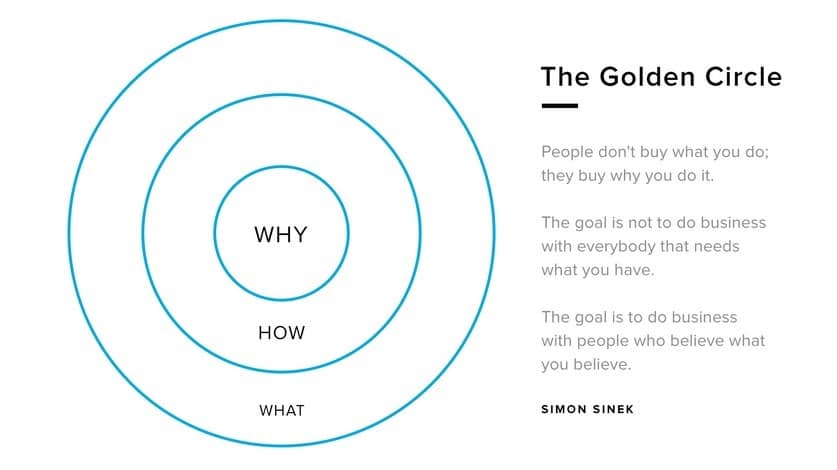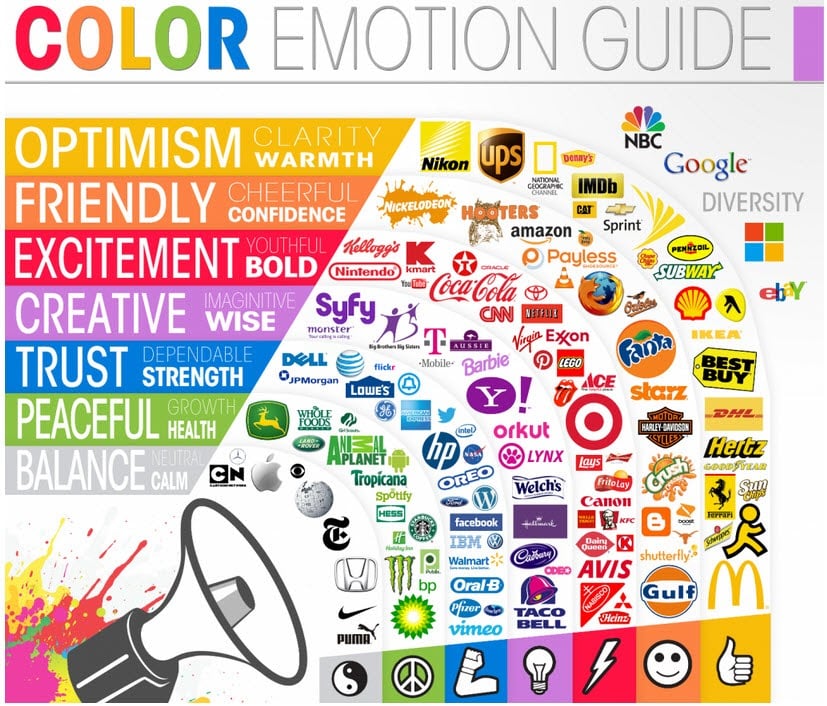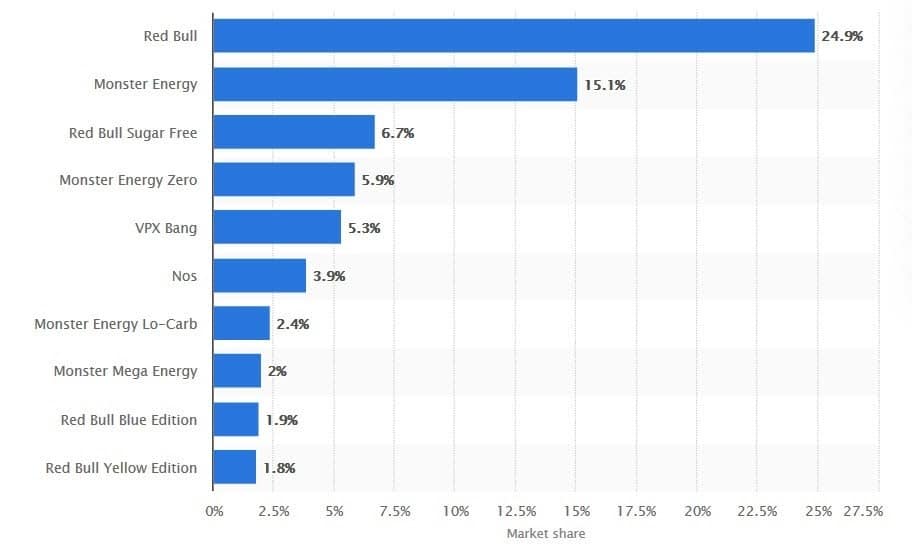Companies with excellent brand strategies know how to plan for the future. In this post, you’ll learn about brand strategies and why it’s so important for your business to have one. You’ll also see actual examples of how some of the biggest names create and implement their brand strategies.
What is a brand strategy?
In the world of business, it’s difficult to succeed without having a strategy for your company. This is why many companies develop brand strategies. So, what is a brand strategy? It’s a way for a company to use its available resources to develop short and long-term business goals. If you do it right, a brand strategy can have major benefits for your company.
Author and motivational speaker Simon Sinek has a great quote (pictured below) that highlights the importance of having a brand strategy.
Why your brand needs a strategy
After learning what a brand strategy is, it’s understandable to wonder why having a brand strategy is so beneficial. A brand strategy can affect everything from the types of customers your business attracts to the employees you hire. Here are three major reasons why your business needs a brand strategy.
Creates a deeper connection with your customers
It’s rare for a business to not have to deal with the threat of competition. Considering that, it’s helpful to do everything possible to give your company a competitive advantage. Fortunately, you can do this with a brand strategy.
Having a brand strategy helps your company stand out from its competitors. By creating a brand strategy, you have a way to connect with your company’s target audience. This strategy can inform the public about what your company stands for and its story, creating personal connections with your customers. Cone’s 2017 Corporate Social Responsibility Study found that 87% of consumers will purchase products from companies they share values with.
Also, having a brand strategy is extremely beneficial for companies wanting to increase revenues. With a brand strategy, it’s much easier to create a consistent experience and avoid going off-brand. You might even create brand loyalists.
Extremely helpful for creating a company culture
While thinking about the future of your business, it’s sometimes easy to forget about the importance of company culture. Not having a culture can have negative effects on your business. One recent study found that 35% of job seekers would pass on the perfect job if the company’s culture wasn’t a good fit.
By having a brand strategy, it’s easier to create clear objectives for your employees. This helps to ensure that each employee has clear expectations and a well-defined role. By doing this, you can avoid the costly effects of employee turnover. It’s important to note the turnover costs vary because most companies have various roles for their employees. To determine how much employee turnover is costing your company, The Huffington Post has a handy equation.
When a brand has both a strategy and culture, it helps give purpose to each of its employees. These companies tend to have both short and long-term goals with clear explanations of how to reach them. By ensuring each employee has a purpose, it typically makes them happy to be at work. CultureIQ noted that companies with strong cultures reported 20% higher employee satisfaction.
Is a great way to expand your business
Almost every business has the same goal in mind, which is to watch their respective companies grow. If you’re in the same boat, it’s wise to think about having a brand strategy. A brand strategy allows your company to carefully plan out and execute its next moves.
When you’re making calculated decisions based on research, releasing new products and services becomes much easier than normal. Creating a brand strategy that focuses on consistent growth can have a positive impact on your company’s profits. Research shows that companies using a consistent brand presentation in their brand strategies can see revenues increase by up to 23%.
How to develop a strategy for your brand
Now that you understand the benefits of having a brand strategy, you probably want to begin creating one for your business. While this might seem like a daunting task, it becomes much easier after you follow a few steps. Here are five actionable steps to take to begin developing a brand strategy.
1. Ask yourself questions to gain a deeper understanding
Throughout life, it’s difficult to get far without asking questions. If you’re trying to determine a brand strategy, you’re going to need to ask lots of questions about your company. You might it find it beneficial to begin this process by asking yourself these questions about your brand:
- What is the purpose of my brand?
- What is my brand’s story?
- What is the problem or problems that my brand solves?
- If my brand was a person, what would its personality be? Who would it be a great fit with? Who would it not pair well with?
How do these questions play into your company’s brand strategy process? By understanding the purpose of your brand and its story, it’s easier to create a great strategy. Also, looking more into what problems your brand solves can help with strategizing.
Take a moment to think about yourself and your personality traits. Your traits and characteristics likely have a huge influence over your life. If you’re like most people, you probably have several friends who share some of your interests. For instance, someone who spends lots of time playing music probably has a few friends who are musicians. Someone who enjoys playing video games will likely build friendships with people he or she meets while playing these games.
By applying this same concept to your business, you’ll have an easier time understanding what your brand is all about.
2. Learn more about who your brand is targeting
One of the most important things about a brand strategy is understanding who this strategy is for. If you don’t know who your company is trying to reach, it’s difficult to create a brand strategy template to follow. Fortunately, there are many tools and options available to help you achieve this goal.
You can utilize brand mention tools and website analytics to get actionable insights as to how people feel about your company. While looking at this data, make sure to learn more about these important aspects of your target audience:
- Age
- Location
- Spending habits
- Interests
Learning about the age range of your customers can help determine their interests and many other factors. For instance, it’s not a stretch of the imagination to assume that most people in their 20s won’t share a lot of interests with people in their 70s. If you’re unable to find information about interests, use age information to make these types of determinations.
Location is another helpful factor to look at while trying to learn more about a target audience. By taking a closer look at the locations of your customers, you’ll have a good idea of what times to target them with your company’s advertisements. This way, you’re not sending out marketing communications in the middle of the night when most of your customers are sleeping.
If it’s available, you’ll also want to look at information regarding the spending habits of your customers. This gives you more of an idea regarding how much money your target base has and is willing to spend. It’s also a great way to determine how your company’s products and services fit into your target audience’s budget.
It’s also incredibly wise to look at your customer’s interests. By learning about this, you can find out more about what companies your target audience prefers. You can also learn about your audience’s favorite television shows, movies, teams, and much more. All of these factors can help tailor a winning brand strategy that aligns with the interests and beliefs of these individuals.
Coca-Cola recently used audience insights to increase sales as part of its “Share a Coke” advertising campaign. During this time, Coca-Cola worked hard to ensure that each batch of these cans had names, locations, and terminology that were different and relevant to each country it was targeting. After this campaign began, Coca-Cola noticed that soft drink sales rose from 1.7 billion to 1.9 billion servings per day.
3. Take a second look at your company’s logo and branding
To create a deeper connection with your audience, taking a second look at your company’s logo needs to be a part of your brand strategy. A logo is one of the most important aspects of a business. Considering that, you need to make sure that your company’s logo is an accurate reflection of your brand and its strategy.
The image is extremely helpful for learning about color in company logos and the effect each color has on the human brain.
If you own a company that’s trying to appeal to a more youthful audience, it might be wise to include shades of red into your company’s logo and branding. For instance, both Lego and Nintendo use this color in their logos and they’re doing great at appealing to younger consumers.
It’s also worth looking at the fonts you’re using when you create a logo for your brand. Are these font choices an accurate representation of your brand? If you were to look at the image above and find the Barbie logo, you’ll notice that it uses a rounded font and text color that appeals to a younger generation of females.
To create a more serious tone with your company’s logo, it’s beneficial to think about using Serif fonts. These iconic fonts help to reflect an established tone with your brand. Looking at the examples of Serif fonts below, you’ll see brands with logos that focus on a historical and authoritative brand strategy.
4. Take inventory of anything that might be “off-brand”
As you continue working to form a brand strategy, you’re likely going to find things about your business that simply don’t fit in with your company’s new message. This can be many different things, including a product that isn’t selling well or a recent advertising campaign that didn’t align with your company’s message.
If you encounter any aspect of your business that conflicts with your company’s culture or message, it’s time to remove it. After doing this, you won’t have to deal with confusing, off-brand aspects of your company. To learn what happens when a company goes off-brand, check out our post that features examples of how not to extend your brand.
5. Research the brand strategy templates of your competitors
By this point, you’ve probably learned a lot about your business and the audience you’re trying to reach. Now, it’s time to fine-tune your brand strategy based on that of your competitors. This doesn’t mean simply copying everything that they do. Instead, take a closer look at each aspect of this company. After doing that, take an inventory of what you feel works and doesn’t work for each competitor.
To find out what brand strategies your competitors are using, take a closer look at their:
- Logos
- Website layout and content
- Advertisements
- Reviews
- Social media pages (engagement metrics, comments, mentions)
After digging deeper into these areas, take inventory of what each competitor is doing right and wrong.
Are you noticing a certain competitor that is getting more positive Google reviews than everyone else? Go through these reviews and find out what aspects of this company’s strategy are creating so many brand advocates.
Is a competitor doing much better than your company regarding social media metrics? Visit these pages and look at what they’re doing to increase engagement.
By spending time learning more about your competitors, you’ll know what they’re doing great and what needs work. By mimicking what competitors are doing right and avoiding what they’re doing wrong, you’ll be able to create a winning brand strategy.
Examples of how companies develop brand strategies
It’s a good idea to learn how impactful the right brand strategy can be for a company. When it’s done well, it can pay off in more ways than you might think. Certain businesses found nothing but positives after changing their brands. Here are four great examples your company might want to use as a brand strategy template.
Airbnb
While you’re creating a brand strategy template, make sure that your company’s customers are at the forefront of it. As an example, it’s wise to take a closer look at Airbnb’s brand strategy.
This company faces more challenges than you might think. One challenge was that this company didn’t have anything tangible of its own. It was great at connecting people with properties, but it wasn’t only the company doing this. Making matters worse, Airbnb didn’t have a unique product to make use of and they didn’t own any of these properties.
Brian Chesky, CEO of Airbnb, highlights the change in his company’s brand strategy by giving the quote below in an interview with The Branding Journal:
Instead of focusing on properties, Airbnb changed focus and placed more attention on consumers with its “Belong Anywhere” campaign. This brand strategy focused on the experience of Airbnb’s customers.
Being that this is an unconventional company, it went for an unconventional marketing strategy and it paid off. By focusing on the customer and their experiences, it helped create a tight-knit community. Instead of offering boring property listings, it shifted focus towards everything that people could do while they’re staying at an Airbnb branded property. This resulted in lots of user-generated content for Airbnb and only helped boost this brand and its service.
Another success during this campaign came when Airbnb invited users to design its logo. There were over 80,000 logo submissions to this company’s website, each submitter likely creating a personal connection and feeling more involved with Airbnb than ever before.
Crayola
If you were to think about Crayola, the first image that comes to mind is probably its signature brand of crayons. Before it was Crayola, Binney & Smith Company produced and sold pigments for red barns. Amazingly, Crayola didn’t start producing crayons until about 20 years after the founding of this company.
One Crayola employee began noticing that school teachers and students needed wax crayons that were affordable and safe. Realizing the potential for a solution to this problem, Binney & Smith Company began producing and selling crayons. These crayons became so popular that the entire company would rebrand itself as Crayola.
It’s understandable to assume that Crayola might be in trouble in today’s digital world. Fortunately for this company, research shows that Crayola maintains around 50% of the market share for the $1.9 billion arts and craft sales market in the United States. Also, Crayola creates a staggering 12 million crayons each day as well as colored pencils, markers, paints, and a range of similar products.
However, this company isn’t shying away from the digital side of things. Crayola offers many great examples of how a company like this one can connect with others by looking at its social media pages.
It’s also had a lot of success with a recent campaign that asked Twitter users to help name some of its new colors. Social media campaigns like the previously mentioned examples help to make customers feel like they’re personally involved with the development of these companies.
By creating these types of contests, Crayola’s brand strategy incorporates digital aspects while focusing on this company’s traditional arts and crafts products.
Old Spice
It’s understandable to feel that your company has grown stagnant. If you’re looking for a way to revitalize your business, take a few pages out of Old Spice’s playbook. Founded in 1934, Old Spice became known for its signature aftershave. However, as time would pass, this brand quickly became outdated and uncool in the minds of many. While Old Spice had a base of loyal customers, it was mostly made of older men who only purchased its aftershave.
After partnering with marketing firm Wieden + Kennedy, Old Spice created a new brand story. Beginning in 2006, this firm would completely change Old Spice’s brand strategy. Undergoing a complete rebranding, Old Spice would start targeting a new segment of its target audience. An example of this is 2010’s “The Man Your Man Could Smell Like” campaign.
Old Spice’s current marketing partner wanted to make use of a study that showed 60% of men’s body wash purchases were made by women. Considering that, this campaign had “The Old Spice Guy,” Isaiah Amir Mustafa, humorously speak to a female audience about their male partners in these ads. The results of this campaign led to a 200% increase in Old Spice Red Zone Body Wash sales.
Throughout the years, Wieden + Kennedy would create numerous viral marketing campaigns for Old Spice that combine humor and advertising perfectly. Another notable “Old Spice Guy,” actor Terry Crews would star in several of this company’s iconic advertisements.
After changing its message and advertising strategy, Old Spice was able to drastically increase its reach and brand equity.
Red Bull
For a short time, Red Bull seemed to have a stronghold over the energy drink market. Debuting in America in 1997, this company would soon notice a huge demand for its product. However, by the early to mid-2000s, many other companies were trying to enter into this market. Notable contenders include VPX and Monster, to name a few.
With lots of competitors popping up fast, Red Bull needed a way to distinguish itself from the competition. Fortunately, Red Bull’s brand strategy would play a major role in helping the company take care of this problem. One of the key strategies this company used was to increase brand awareness by bringing their products closer to Red Bull’s target audience.
Soon, Red Bull would be sponsoring music festivals, extreme sports competitions, and anything else that was relevant to its younger target audience. Red Bull also developed its own film production company that produces documentaries and films based on extreme sports, a perfect extension for this company’s brand strategy. You might even remember this brand’s video marketing strategy of attaching itself to Felix Baumgartner’s record-breaking skydiving stunt in 2012.
Red Bull would spend about $30 million to attach its name to this event, a fraction of its annual marketing budget. This aspect of Red Bull’s brand strategy paid off in a big way. Not only did Baumgartner’s jump get 8 million live viewers, but the YouTube video currently has over 45 million views. This means that there are a lot of people who saw and still see Red Bull logos and advertisements on this one video.
By creating and expanding upon its brand strategy, it’s continued to appeal to people who share Red Bull’s values.
Check out more iconic and inspiring brand strategy examples, shared by experts.
Conclusion
Forming a brand strategy is beneficial for companies of all sizes. Brand strategies help form the connections you create with consumers, employees, and business partners. To develop a brand strategy, you’ll need to learn more about your company and its competitors. However, after putting in this time and effort, you’ll likely find that creating or improving a brand strategy pays off in lots of ways.












